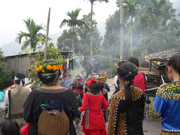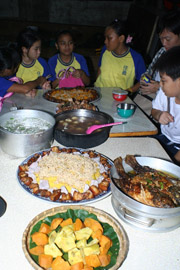What would it be like to sing, dance, eat and stay over in the Chief’s house in an aboriginal village? Actually the teachers were not even sure, since it would be a first so it would all be a new experience. Much time was spent during planning, communicating and most importantly in ensuring students’ safety. Take a look at the process, from pre-trip visits to actually setting out, and share our growth.

◎Record of Dream Search:
A long trip – Dream Search Night (08/12/2006)
Recorded by: Hsiao-ning, Hsiao-rong
It is 1:30pm and we met in the corridor after changing into aboriginal clothing, to fetch our sleeping bags. We all carried smiles but were a little scared at the same time, since we were going to spend the night in the slabstone house and would only come home tomorrow at noon. We loaded the 3 cars with the necessary sleeping bags, food, water, knife and backpacks, and after taking photos in front of the cars we begin our journey.
After passing Beiyeh Village, the cars entered the winding part of the road, where we ascended from 50m above-sea-level to 850m above-sea-level. Although it wasn’t our first time visiting Old Paiwan Village we still felt just as excited as that first trip, and only quietened down when we passed over the cliff edge. We drove for about 25 minutes over the snaking mountain route and stopped at the abandoned Majia Elementary School for a short rest before walking a further 20 minutes to reach the stone wall, which was previously a slabstone harvesting-ground where, before machinery tools arrived, grinded tools were skilfully used to knock off sheets of stones that were carried to the village – it’s difficult to imagine the time required to build a house with so many stone slabs, since it takes about 40 minutes to travel from here to the village. We could already see the village clearly over the slopes from here, there were about 200 houses across 100m.
In 1931 (Japanese Occupation Period) Paiwan Village had a population of 1604 people, thus it was a big village, however later on due to mountain slides the transport became inconvenient and the tribesmen slowly moved out, till in 1963 only 87 families or 528 people remained. Currently the population should be less than 10 people. It took another 5 minutes in the cars before we arrived, but from far we could see that the chief, elder and shaman had been waiting for us, and smoke columns rose from the village entrance. They each held a fig-tree branch and grass bundles laid before them, so none of us wanted to be at the front and we all huddled together when we got off.
After getting off the cars and tidied our clothes we lined up with the teachers and listened to the chief, who explained that that before we can enter the village someone has to announce to the mountain god and ancestral spirits that guests have arrived, and that evil spirits from the outside must be driven away. Therefore under the watch of the chief and the words of the shaman as he waved his fig branch (for its spiritual cleaning ability), everyone waved their branches and said, “Bad spirits! Bad spirits! Go away!”while we crossed the fire and grass bundles (with sharp edges that wounded evil spirits). We then threw away the branches and entered the village with clean spirits.

We also had fun with singing and dancing with the chief and officially concluded one lesson.
The chief then led us into the village and introduced its history as we walked. At the village’s announcement podium there used to be a large rock where one could stand atop and make announcements to the whole village, it also allowed lighting of fireworks to convey signals, however after the Restoration it was shattered into smaller rocks and can still be seen. The chief also explained the functions of fireworks, which were lit for important events and messengers from nearby tribes would arrive to take back the news. The elder also announced to the village of the arrival of guests, so that everyone would treat guests with hospitality. We then visited Elder Jin’s slabstone house where he displayed the raincoat he weaved himself from the Aspidistra plant planted next to the house. We were able to take pictures with the elder in his raincoat and traditional spear. Afterwards the chief hurried home so that he could dress formally before our visit.
We used this time to look for kapaiwan by the cliff edge, Chief Jin also told us where Paiwan Village’s last head rack stood, behind the bamboo tree below. After the chief was ready we begin to walk to his house with our luggage. Along the way we were all very high spirited, since it felt like a graduation tour. It is a tremendous honor to visit the chief’s house, first elder reported that guests had arrived to visit Qapulu’s chieftain house and whether the chief would accept them, then the chief treated his guests with water, which if taken, would signify the bonding of blood and that we had become one family. The ceremony ended after we presented our gifts and the chief’s welcome speech.
We received a tour of the chief’s house from the chief. It had very low eaves, which, although the chief had jokingly said was made according to height, but actually served two purposes: the first was that to bow one’s head when entering a house showed respect to its owner, and the second was for defensive purpose. After entering the house we first saw the kitchen, followed by the living room and bedroom. The beds were different for those who are married and those who have yet to marry, and between the two laid the children’s beds, while the innermost bed belonged to the oldest member. The walls were decorated with animal bones from muntjac, boars and goats. There were also pottery and in the middle of the house stood a spirit pole, in front of which was the elder seat, which was not allowed for use by others. After being introduced to the indoor decorations we sat on the green grass in front of the chief’s plaque outside his home and listened to the Vuvu’s songs, which were made even more beautiful by the nose-flute in the background. The Vuvu and elders spoke about the times they visited the houses of girls they had liked and how the boys would play their nose-flute while they girls listened inside, and about how even after being invited the boy and the girl would sit far from one another and could only steal glimpses. I looked at the expressions of the Vuvu and elder as they immersed themselves in the past and wondered, in this fast-paced generation this conservative form of dating seemed very unique. The visit at the chief’s house ended with the sounds of our hunger, so we readied our own utensils and prepared for the aboriginal feast.

The dinner feast was set up at Elder Jin’s house and cooked by an aboriginal cuisine expert, Teacher Lee. The sounds of cooking and delicious smells teased at us while dish after dish of tasty foods appeared. Common ingredients such as pumpkin, rice, yam and wild cabbage were infinitely transformed by the skills of Teacher Lee. After praying with Elder Kin we all enjoyed the wild feast.
The night in the mountain was so quiet, only the teacher’s stories and snacks we brought accompanied us. After 8pm the stars began to appear and the teacher gave us an astrology lesson. The house faced north-eastwards so the Orion constellation was seen clearly, and a well-timed Greek myth immediately caught our attention. After 9pm a half-moon appeared from behind the mountain, and it was our first time seeing a moon-rise. Three gunshots sounded from far – I wonder how many animals would die tonight. Even though animal conservation has long been promoted, yet for aborigines hunting has been a part of life so it is hard to stop. After 10pm we started to tell ghost stories and the shrieks and running were especially loud in the silent night; mountain spirits please forgive us! At 11pm the teachers called a stop and all returned to quietness. Good night mountain spirits! See you tomorrow.
The early morning in the mountains was especially thought-provoking. Thin mists covered North Dawu Mt. and the haziness made it look different. At 6:30am the teacher rushed us out of the sleeping bags to look at the mountain from in front of the house. From the right rose North Dawu Mt., Chapuyan Mt., Wutou Mt. and Jinbu Mt. (or Ahou Fuji Mt.). The Shelu Tribe on the opposite slope and Chiyan Mt. could be seen clearly.With the map laid out before us according to the bearings we learnt more about the geography of Paiwan Village. With our tummies rumbling we ended our morning class and prepared our luggage for the next highlight.
Top |
